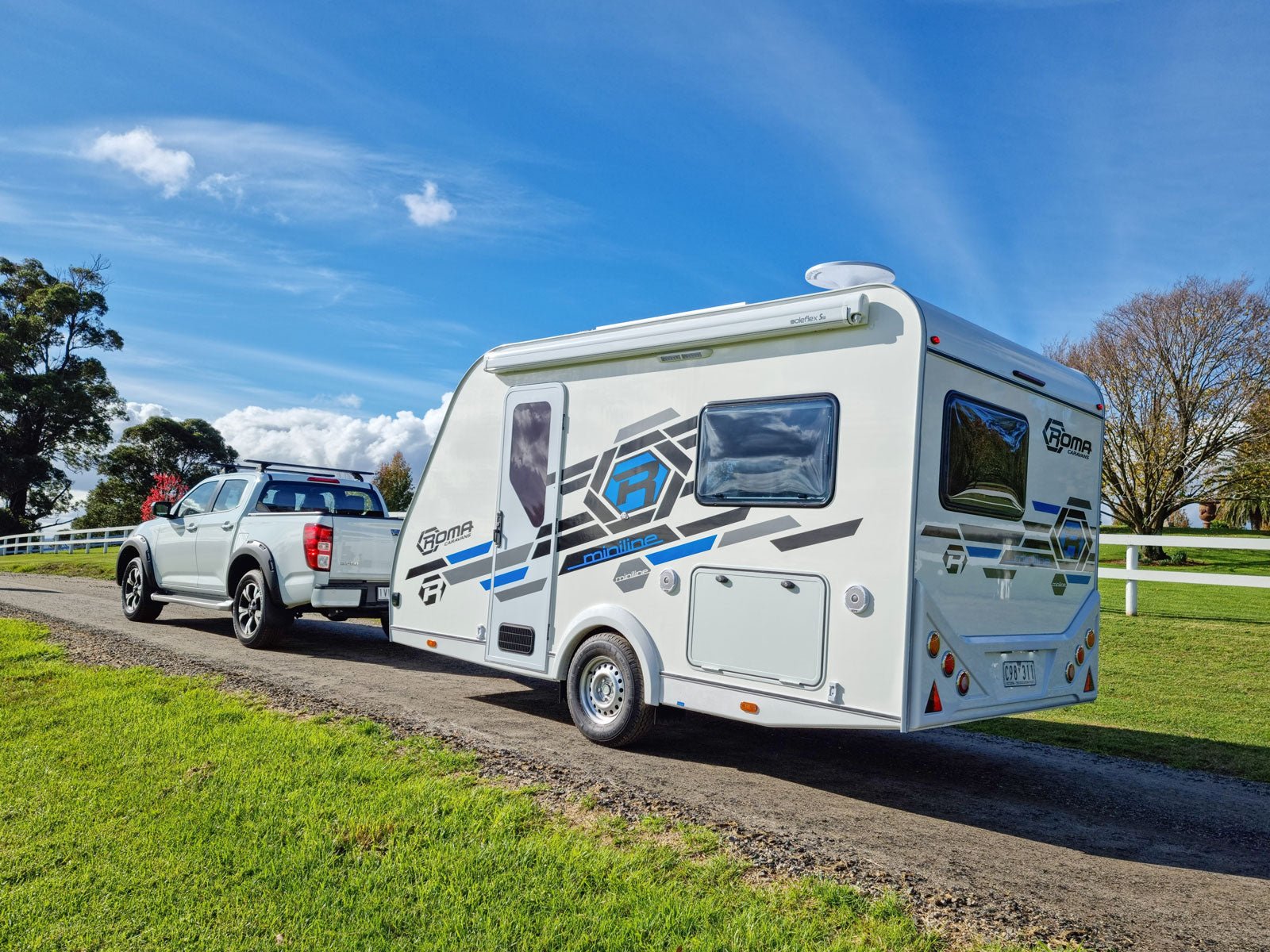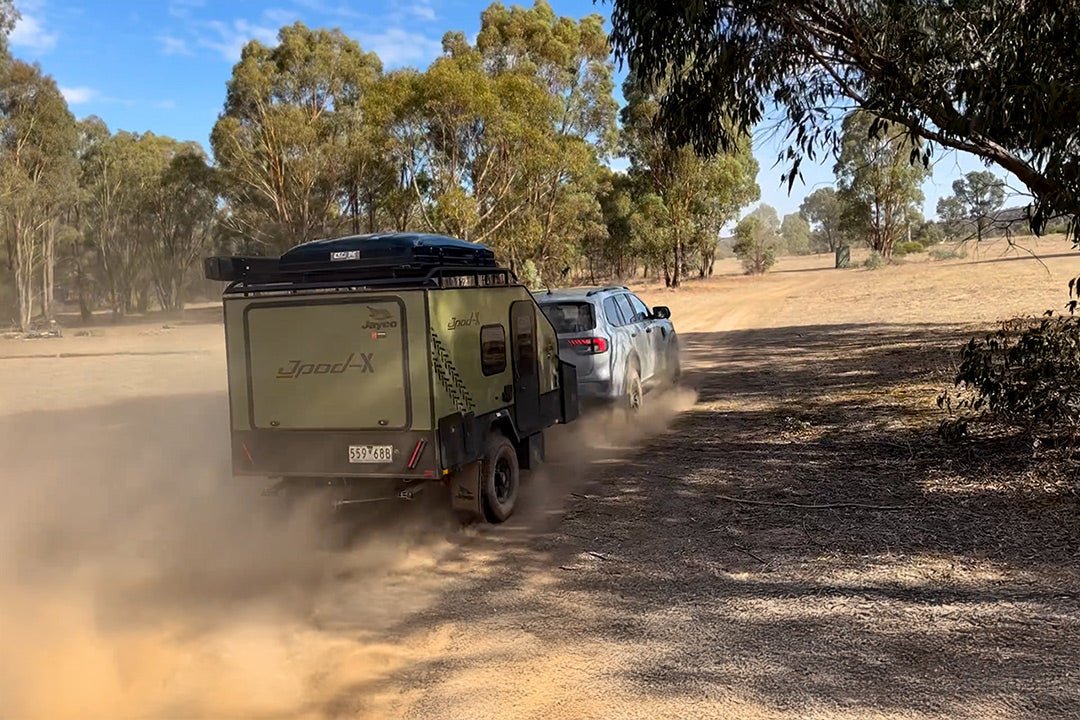Review: Roma Miniline

Roma has quite a backstory — it has been manufacturing in Australia for over 90 years with a strong family tradition. On hand to tell the story was third-generation family member Mark Palmarini and colleague Olivia Asprea.
Roma covers a lot of bases in its RV range, manufacturing classic Australian-style caravans geared for long-range touring complete with a heavy-duty chassis and checkerplate as well as offroad specs. Roma has also recently entered the motorhome category, with a smart little unit built on a Fiat Ducato platform. Roma is also the Australian importer of Alto caravans, a highly innovative compact teardrop-shaped van with a lifting roof that reveals expansive windows. In this review, we look at another unique product, the Roma Miniline — it’s a special little van with a very European flavour that takes a completely different approach to the typical Australian offer.
Small Vans, Big Future
I have spent a fair bit of time in European caravan parks, and there are a couple of standout differences to what you typically see pulled up in an Aussie park. Motorhomes are much more prevalent, and caravans are typically much smaller. It is not uncommon to see tiny vans being towed by little 4-cylinder hatchback cars. The Miniline is in that mould, weighing in at 1260kg with a body length of just 14ft.
Mark told me that the vans his grandfather built were often around this size. He expects a resurgence in compact vans, seeing environmental and economic factors swinging us towards more efficient RV solutions. The current generation of electric cars have limited towball ratings and towing range. The Miniline, with a tow ball at tare of 110kg and an ATM of 1560kg, is electric car friendly. Even if you are not an electric car convert, these diminutive dimensions will deliver great fuel savings in an internal combustion engine car. Plus, the Miniline will happily sit behind many SUVs rather than needing a big four-wheel drive (you can see on the day, we did tow with a four-wheel drive ute, and it was a picnic). Upward price pressure on just about everything including caravans is making the aspiration of caravan ownership unreachable for some. Small vans such as the Miniline, priced at under $60K, keeps the door open for many.
Layout Masterpiece
When you only have a tiny amount of space to work with, you can’t afford to waste a cubic centimetre, and Roma has tackled this challenge. The first thing everyone wants to know is what the sleeping and bathroom arrangements are like — this little van sleeps three and boasts a combination shower and toilet.

This is achieved by use of a corner bed, the aforementioned combination shower/toilet, and café seating that converts to a single bed. Of course, there are compromises in a van of this size. The corner bed is narrower at the foot end to allow a bit more passage space for the kitchen and bathroom. The foot of the bed is also hard up against the fridge cabinet. Having said that, the bed will accommodate two average size people very comfortably. As with all vans, converting the seat into a bed takes a little bit of effort, but is very useable if you can be bothered. I think most people would view this as a couple’s van that could accommodate a child for an occasional sleepover.

The combination shower and toilet felt surprisingly spacious, and this was achieved by using quite a compact vanity. The trade-off is limited bench and storage space, but there is a limit to what you can have in a 14ft van. You do get a small overhead cupboard in this wet area, but what is interesting is that it’s made out of poplar ply. Mark assured me this material won’t swell or rot. The same poplar ply construction is used in the furniture throughout which also has the benefit of reducing weight.


I rate the storage solutions very highly for a little van. Overhead cupboards are plentiful — just be careful when you open the ones in the corner above the bed, otherwise you will bang the doors together. Cavernous under-bed storage is accessed externally from a sizeable hatch. Kitchen drawers and under sink cupboards are more than adequate. You get some more large storage space above the compact fridge. The only area you lose out compared to a bigger van is a lack of bedside cupboards or drawers.

The kitchen is compact with a NCE 2 burner gas stove and NCE rangehood. There is no oven or grill, but there is a handy microwave. Bench space is optimised with a round chopping board over the sink. The leatherette cafe seating is ample, and the table has a swivel extension for a bit more horizontal space or to accommodate a third person. And as you see with many European-inspired vans, there is a lovely front window to afford a view when dining. In a small van, I think this is a winner — it really does make the van feel so much more open.
Talking about the windows, I loved the operation of these ones. When you pushed them out, they stayed exactly where you left them. A lot of other windows are very fiddly to keep open. If you are new to caravanning, you will also find the Miniline windows very intuitive to close; there are no tricks to it.

Technology
The Miniline isn’t lightweight just because it is small — it has a lot of contemporary technology. If we start by looking underneath, you will see very little chassis and a lot of floor. The chassis is manufactured by AL-KO. The rails are C section and it has very few structural members to save weight. The rigidity in the chassis comes from pairing it to the one piece sandwich floor.
The AL-KO chassis is also mated to a few other AL-KO components that are a little different than what you see on most conventional vans. The Independent Rubber Suspension is more lightweight than most other independent suspension systems due to its simple design with no heavy parts.

Upfront on the A-frame is an AL-KO anti-sway coupling. AL-KO literature explains the system incorporates a clamping system that grips the sides of a specially designed 50mm towball which resists movement of the van, slowing down any tendency for sway or veering from a straight condition. Also, upfront are mechanical override brakes. These are in fact old-school, but perfectly adequate for a van of this weight and they have the added advantage that you don’t need to get your car fitted with an electric brake system. The final AL-KO component upfront of interest is the jockey wheel which stays mounted to the caravan when travelling — you just pull it up and clamp it into place. Not having a loose jockey wheel to store is one less hassle to deal with.

The aluminium-framed walls and roof also feature composite panels that keep weight down and are well regarded for insulation properties. An interesting benefit of this light weight surfaced when Mark and Olivia showed me that the van can be very easily manoeuvred by hand by two people on a hard flat surface. Sometimes this can be easier than using the tow vehicle in a tight spot but you do need to be very careful that the van doesn’t get away from you if you push it towards a downslope.
Caravan Park Friendly with a Dash of Adventure
The Miniline is clearly going to be more at home in caravan parks than bush camping. It is also very well-equipped for short stay, easy access roadside free camping. You get 80 litres of fresh water and 80 litres of grey water. I really like the fact that the grey water tank is as big as the freshwater tank, as you can actually catch all of your used water. That is a very rare thing in bigger Aussie style vans. Two 150W solar panels and a 100Ah AGM battery is a really good spec for the intended purpose and the 9kg gas bottle is plenty. The 75L 240/12v Evatech compressor fridge is in keeping with the compact nature of the van and will keep a couple well stocked for caravan park stays.

Bush camping is not out of the question. The main constraint would be limited access to some rougher locations as the Miniline has limited ground clearance and small wheels, but the van is helped somewhat with a little cut out at the rear to assist with departure angles. On our day out reviewing the van, we did traverse well-maintained dirt roads and slipped out to a local paddock for a few shots. We just took it slow and steady.
The wind out awning will protect you from the elements wherever you are. A neat little thing I appreciated was the awning winding handle was mounted inside the van proper just inside the main door which was very easy to access.
The Bottom Line
In recent years, consumers have been captivated by big offroad vans, and many pages of our magazine have been dedicated to them — but there is a lot to be said for the advantages of a small van geared for on-road use. The Roma Miniline is a refreshing example of simplicity, intelligent design, and good engineering that come together for lower cost caravanning — in both initial outlay and ongoing expenditure.
Hits and Misses
Hits
- Lightweight is a winner for ease of towing and fuel efficiency
- Able to be towed by many vehicles
- Great layout utilizes just about every cubic centimetre
Misses
- Be careful using the lockers above the bed to prevent banging doors together
- Some of the cupboard doors had blemishes on them
Ratings
Value for money : 8
“The Miniline will get you into a brand new van for less than $60k.”
Towability : 9
“Tow it without just about anything. Be careful on rough roads”
Suitability for intended touring : 8.5
“Great for a black top, short stay touring or longer for minimalists.”
Build quality : 7.5
“Overall construction was sound, a few blemishes on door corners prevented a higher score.”
Liveability : 8
“Embracing its simplicity and compact living, you will find a lot to like.”
Self-sufficiency : 7
“It’s not a remote off-grid tourer but fine for a couple of nights of civilised free camping.”
Customer care : 7
“Warranty is two years on the body, which is under par these days.”
Innovation : 8.5
“Makes the most of contemporary materials to deliver a lightweight van.”
X-Factor : 8.5
“I just think this is a clever little van that makes so much sense.”
Roma Miniline Specs
Weights and measures
| Body length |
4.3 M (14ft 1in) |
| Overall length |
6 M (9ft 9in) |
| Width |
2.2 M (7ft 2in) |
| Height | 2.8 M (9ft 3in) |
| Tare |
1260 KG |
| ATM |
1560 KG |
| Ball weight |
110 KG |
| Payload | 300 KG (calculated) |
External
| Frame | Aluminium |
| Cladding | Composite walls |
| Chassis | AL-KO fully galvanised |
| Suspension | AL-KO IRS |
| Coupling | AL-KO AKS 1300 anti-sway |
| Brakes | Mechanical override brakes |
| Wheels | 195/65 R14 wheels |
| Water | 80L freshwater tank, 80L grey water tank |
| Battery | 100ah AGM |
| Solar | 2x 150W |
| Air-conditioner |
Belair 2400 roof mounted |
| Gas | 1x 9KG |
| Sway control |
AL-KO AKS 1300 anti-sway |
Internal
| Cooking | NCE 2 Burner cooktop |
| Microwave |
NCE 20L microwave |
| Fridge | Evatech 75L 240/12v compressor fridge |
| Bathroom | Combination shower and toilet |
| Hot water |
Fogatti Instant Gas |
Price from $58,000
Supplied by Roma RV







